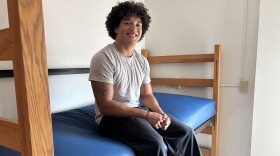Central High School senior Kellan Barbee has a straightforward style: navy fleece sweater, loose gray pants.
He’s never got in trouble with the dress code, but many people he knows have. And last year, he decided it was time for an update.
“It was created before a majority of our high school students were born,” says Barbee, who serves as one of four student representatives to the Manchester school board. “The original language of it is from the eighties.”
After months of talking to students and district administrators, Barbee rewrote the dress code, which got final approval from the Manchester school board last week. It is the first policy in the district authored by a student.
The new code allows several items that were formally prohibited, including spaghetti straps, tube tops, ripped jeans, do-rags, bonnets and hats. The district will continue to prohibit wearing the hood of a hoodie, see-through clothing, and attire displaying messages with profanity and hate speech, among other things.
Students had been pressing the school board to update its dress code for years. Some of the pressure came from Youth Organizers United, a Manchester youth group affiliated with the progressive Granite State Organizing Project. That group also helped push for student representation on the school board, which was approved by city voters in 2019.

Some students say the old code singled out female students, Black students and plus-size students. Those out of compliance faced a range of consequences, from being asked to call their parents to bring an outfit from home or find clothes in the lost and found, to getting detention or suspension.
Mackenzie Verdiner, a sophomore at West High School and a member of Youth Organizers United, says under the former rules, her friends with bigger bodies got “dress coded” more often.
“I think what people might not realize is that not everyone has access to new clothing,” she says. “Clothing that they've had for a while might not fit the same as they grow. They might not show more skin, but they don't have access to newer or better-fitting clothing.”
Hats were another point of disagreement in the dress code debate.
Barbee says the district was reluctant to give up its hat ban, but after hearing about homeless peers who didn’t have access to hair products and showers, Barbee made hats a priority.
Ernest Dowell, a junior at West High, says there were other good reasons to allow hats. He and other Black students put a lot of care into their hair, and on days when they don’t have time or the right products, du-rags, hats, and bonnets are their go-tos.

“Sometimes it's like: I wake up and [my hair] is crushed to one side because I laid on it weird so it's like: I want to wear a hat or hoodie,” he explained.
The new dress code states that enforcement will be equitable and not discriminate on the basis of a protected class. Barbee, who authored the code with other students’ input and checked it with the district attorney, said there’s been some criticism about the new policy. But he thinks it accomplished the students’ mission.
“My goal is not to impose my own views on dress –
on students, on staff, on the district. It is to bring student voices to the table,” he said.








